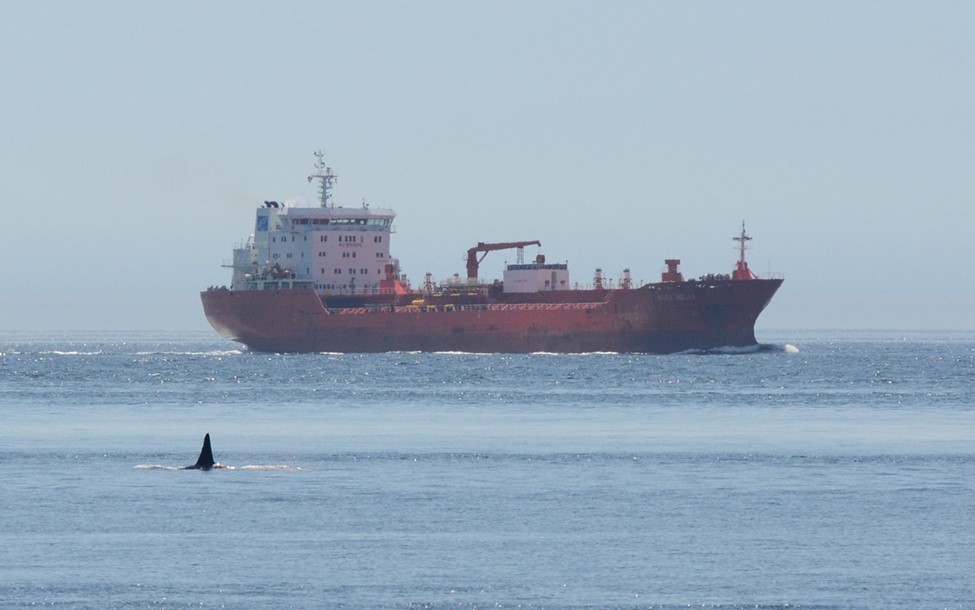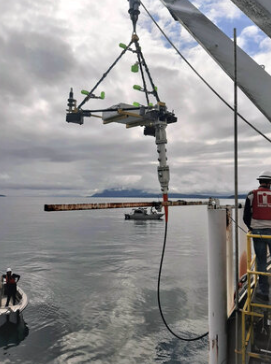Shipping plays a key role in shaping Canada’s economy, but shipping vessels can be noisy. Depending on the frequency and volume, underwater noise from vessels can have negative impacts on marine mammals, such as whales, who rely on hearing for their survival. Chronic noise interferes with their life functions, such as communications, foraging and navigation.
Addressing underwater noise
Since 2018, Transport Canada (TC) has been committed to addressing underwater noise from vessels and its threats to whales. Under the leadership of the Whales Team in Environmental Policy at TC, a strategic framework was developed that identifies short, medium, and long-term actions, including domestic and international efforts, operational and technical solutions, and engagement across all sectors.
An important part of this work was the development of underwater listening stations, complimenting TC’s efforts and advocacy for the construction of quieter vessels.
In 2019, Véronique Nolet began her career with TC. As a marine biologist, she understands the importance of protecting and saving whales. “I’m super happy that TC is exploring ways to reduce the impact of ships on whales,” Véronique says. Co-author of the book A Mariner’s Guide to Whales in the Northwest Atlantic, Véronique is delighted that TC, and the Government of Canada as a whole, are heavily involved and becoming part of the solution.
Véronique works with Matthew Cooke, an engineer at TC. His favourite part of the underwater listening station project is learning how we can become better stewards of the environment. “TC is really pushing boundaries in innovation and investment. It’s great to be a part of a project that is advancing our understanding of underwater noise.”
Taking action by listening
In June 2020, TC deployed a state-of-the-art underwater listening station at Boundary Pass, British Columbia, located along the border of Washington State, directly below a major shipping lane. Here, the listening station can monitor the sounds of vessels coming in and out of the Port of Vancouver
Photo courtesy of JASCO Applied Sciences Inc.
The listening station records all underwater noise, 24/7, helping develop the largest ship noise database in the world. These recordings include all sorts of noises from vessels, whales, nearby pinging buoys, fish, and other marine fauna. The underwater microphones (also known as hydrophones) that are part of the station, can measure and record sound from 4,000 to 5,000 vessels each year.
"It’s cool to see and hear real-time footage and sounds, and watch the ecosystem evolve over time. The recordings help us and our partners identify the sounds produced by different kinds of vessels. Then, we can speak with the scientific community and naval architects to identify which sounds are more harmful for the species. It allows us to find ways to reduce noise from the source,” Véronique notes.
Projects like the underwater noise listening station are part of a huge collaborative effort. TC’s Innovation Centre, led by Jim Lothrop, and Whales Team, led by Michel Charron, work closely with external stakeholders such as the Vancouver Fraser Port Authority’s Enhancing Cetacean Habitat and Observation (ECHO) Program and JASCO Applied Sciences, a private organization that specializes in measuring underwater noise.
While Canada’s coasts and marine species are more protected than ever before, Transport Canada remains committed to preserving and protecting our vulnerable marine environment.
Thank you to our TC employees and partners who are helping to establish a more peaceful habitat for Canada’s marine species!

